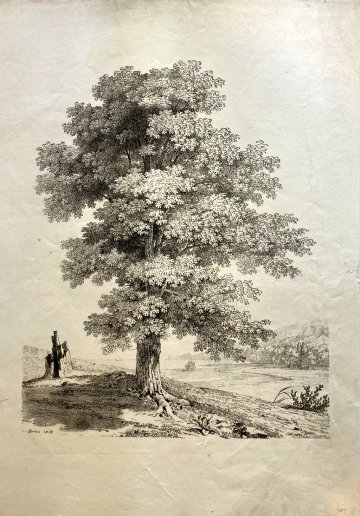Jean Victor Bertin. (Tree study with stump) Paris 1818-20. Framed $1,650.00

Jean Victor Bertin (French, Paris 1767–1842 Paris) Born in France, Bertin was a painter and lithographer.
“Jean-Victor Bertin's art is considered a link between two somewhat philosophically opposed, yet parallel traditions in landscape painting that developed in France in the 1800s. Bertin's paintings are firmly rooted in the Neoclassical school of painting, characterized by tight compositions and smooth brushwork, as well as mythological or antique subjects. But Bertin was also an early proponent of sketching outdoors--a practice of direct observation in order to replicate nature in studio-made paintings of imagined, idealized scenes. Bertin encouraged the practice of plein air to his students, and it later it became a respected genre in its own right.
Bertin attended the Royal Academy of Painting in Paris, initially as a student of history painting, the most highly regarded genre in a rigidly structured, academic salon system. For three years he studied with history painter Gabriel-François Doyen. By 1788, he discovered an interest in landscape painting and entered the studio of Neoclassical painter Pierre-Henri de Valenciennes. Valenciennes devised a new category, the paysage historique, which infused landscape painting with an idealized, heroic view of history in order to bolster respect for the lowly genre. Bertin embraced it throughout his career.
Plein air painting in Italy was a longstanding tradition for aspiring landscape painters. Bertin made scenes of precisely identified Italian locations, suggesting that he may have visited between 1806 and 1808. He painted outdoors in the Ile-de-France region near his home in Paris. Bertin's most famous student was Camille Corot, whose art later influenced the Impressionist painters.”
Reference Getty Museum (Getty education art collection 103M42)
Original lithograph uncolored
22 ¾ x 16 ¾ inches sheet.
Archivally framed
Excellent condition.
or click to inquire about this print.
